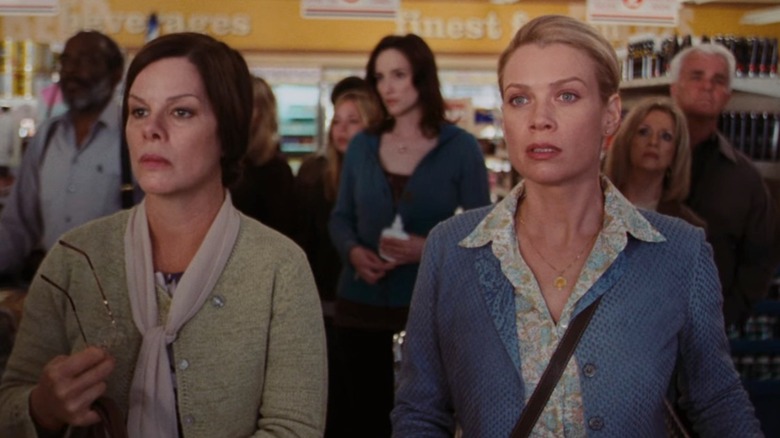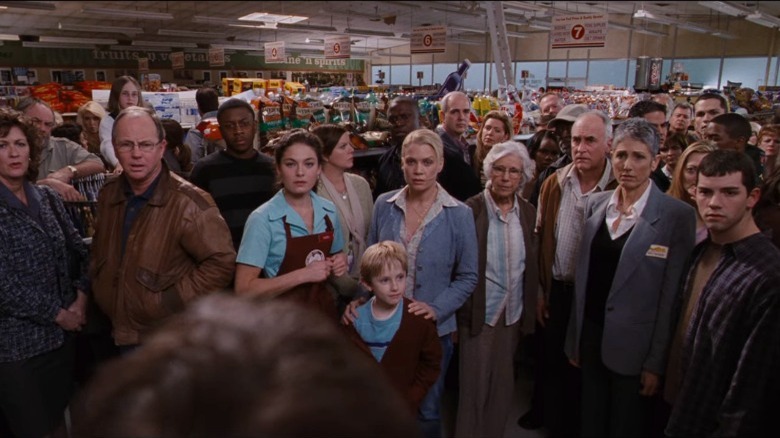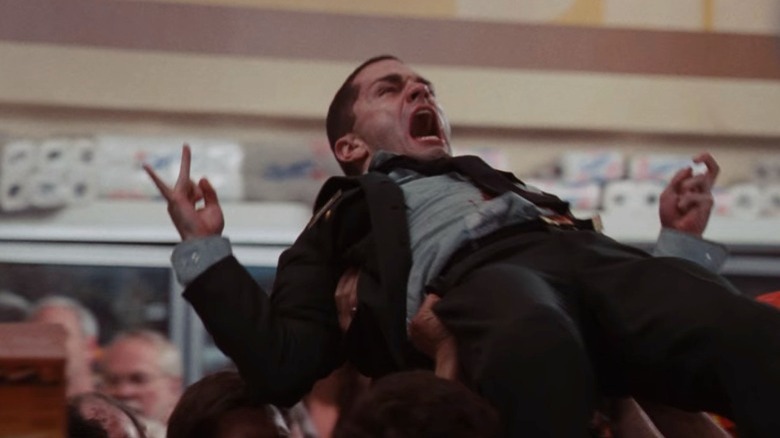Filming The Mist Had The Cast And Crew Flying By The Seat Of Their Pants
Frank Darabont successfully captured the intensely claustrophobic paranoia of Stephen King's novella "The Mist" in his 2007 adaptation. The town of Bridgton gets mysteriously enveloped in a thick mist swarming with eldritch monsters, and most of the townsfolk find themselves trapped inside the local supermarket, which becomes a breeding ground for fear and anxiety. Although the monsters outside the supermarket are a real threat, interpersonal conflict emerges as an even greater threat for the remaining survivors. Instead of banding together to figure out a way to survive, the townsfolk end up distrusting one another, and things take a turn for the worse due to a newly-converted group of religious zealots.
Darabont expertly captures the themes of isolation, faith, fear, and religious extremism, where people commit monstrous acts instead of helping one another. The fanatical Mrs. Carmody (Marcia Gay Harden) manages to convince some folks that human sacrifices will somehow appease the monsters, and the group ends up horrifically stabbing an innocent man and throwing him out in the street. As if this isn't horrifying enough, the group intends to sacrifice a child next all in the name of faith, when in actuality, it is a manifestation of cowardice and cruelty.
These events play out in a realistic, frenetic manner, and add a considerable edge to the horror element of the film. In order to achieve this sort of "fly-by-the-seat-of-your-pants" filmmaking, the cast and crew of "The Mist" had to take an extremely spontaneous approach to the scenes, which also involved a fair amount of improvisation. Here's how Darabont and co. achieved this vibe for the film.
The polar opposite of a Kubrick-ian film
Laurie Holden, who plays school teacher Amanda Dunfrey, told Fangoria about the "renegade" nature of filming "The Mist," which was markedly different from her experience of working on the deliberate, Kubrick-esque "The Majestic." She said:
"That [The Majestic] was very elegant and Kubrick-esque, and this [The Mist] was renegade, fly-by-the-seat-of-your-pants, never-knew-where-the-cameras-were [filmmaking]. You had to be on all the time. It kind of felt like live theater in many ways. The beauty of this was that he cast so many great actors, and everybody fed off each other and fueled one another ... It was really like a live performance that we all had to be in the moment for. It really helped make the film very raw and visceral."
While a Kubrick-esque style of filmmaking would entail precise, choreographed shots and character interactions, Darabont took a more hands-on, theatrical approach to shooting "The Mist." As the core premise involves a group of scared, paranoid folks stuck in a small space, the energy within that environment had to be naturally created without the actors being overly conscious of the camera's position. This approach worked in the film's favor, as it reflected the chaos raging within the supermarket, the hostility of the converts, and how fear can lead to a "Lord of the Flies" sort of situation in the face of cosmic terror.
How cinematography played a critical role
Darabont, along with cinematographer Rohn Schmidt, used handheld cameras to capture the grounded, realistic nature of conflict inside the supermarket, while wide angles were used to capture the lurking creatures in the mist. The contrast between the great unknown in the outside world and the supermarket, which is supposed to be a safe space for survivors drives the tragedy of the situation home, as the survivors end up being monstrous towards each other.
Apart from this, spontaneous, ad-libbed acting moments added greater authenticity to the scenes, making the events that unfold throughout the film seem more believable. For instance, a mother (played by Melissa McBride), who left her children alone at home, pleads with the townsfolk to accompany her safely back to her kids. None of the characters are willing to help out, which causes considerable tension when she expresses her disappointment. When she decides to leave alone, the audience feels her despair, but at the same time, it is understandable why no one helps her: selfishness is a core human trait that rears its head during life-and-death situations, and most people would react exactly the way the townsfolk did.
In Eric Vespe's 15th-anniversary oral history of "The Mist" for /Film, Schmidt revealed that high-stakes shots inside the supermarket were shot with the widest lenses from an overhead angle to accentuate the dramatic nature of the scenes. Also, a recurring crew was used to maintain the tonal consistency of the mob scenes, which came in handy while "communicating the terror" of the subject matter. These factors came together to contribute to the tense, hostile vibe in "The Mist," which was further accentuated by a gut-punch of an ending that still leaves viewers in a state of hopeless despair well after the credits roll.


